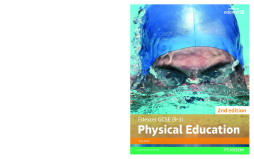
Additional Information
Book Details
Abstract
Exam Board: Edexcel
Level: GCSE
Subject: Physical Education
First teaching: September 2016
First exams: June 2018
Written by Tony Scott, MBE*, this Student Book is designed for students studying the Edexcel GCSE PE 2016 specification and covers all four components of the course. Inside you'll find:
- engaging, fully illustrated topic-by-topic coverage
- clear links drawn between related topics
- accessible explanations of the trickier content (such as movement analysis, anatomy and physiology) with an emphasis on their relevance to sporting contexts
- worked examples to develop confidence in mathematical skills and use of data
- new ‘Apply It’ and ‘Practice’ features to help students use or apply knowledge straightaway
- exam-style questions and tips, including additional guidance for extended writing questions
- support for the linear course with dedicated Preparing for the Exam sections.
*Tony Scott was awarded an MBE for services to education in 2015. He is an inspirational athlete, representing Team GB at the World Transplant Games, where he has won numerous gold medals.
Table of Contents
| Section Title | Page | Action | Price |
|---|---|---|---|
| Cover\r | Cover | ||
| Contents | iii | ||
| Introduction | iv | ||
| Acknowledgements | viii | ||
| Component 1: Fitness and Body Systems\r | 1 | ||
| Topic 1: Applied anatomy and physiology\r | 1 | ||
| 1.1 The structure and functions of the musculo-skeletal system | 2 | ||
| 1.2 The structure and functions of the cardio-respiratory system | 22 | ||
| 1.3 Anaerobic and aerobic exercise | 36 | ||
| 1.4 The short- and long-term effects of exercise | 40 | ||
| Topic 2: Movement analysis\r | 50 | ||
| 2.1 Lever systems | 51 | ||
| 2.2 Planes and axes of movements | 56 | ||
| Topic 3: Physical training\r | 62 | ||
| 3.1 The relationship between health and fitness and the role that exercise plays in both\r | 63 | ||
| 3.2 The components of fitness, benefits for sport and how fitness is measured and improved\r | 66 | ||
| 3.3 The principles of training and their application to personal exercise/ training programmes\r | 81 | ||
| 3.4 The long-term effects of exercise | 98 | ||
| 3.5 How to optimise training and prevent injury | 102 | ||
| 3.6 Effective use of warm up and cool down | 113 | ||
| Preparing for your exam\r | 118 | ||
| Component 2: Health and Performance\r | 124 | ||
| Topic 1: Health, fitness and well-being\r | 124 | ||
| 1.1 Physical, emotional and social health, fitness and well-being | 125 | ||
| 1.2 The consequences of a sedentary lifestyle | 138 | ||
| 1.3 Energy use, diet, nutrition and hydration | 144 | ||
| Topic 2: Sport psychology\r | 153 | ||
| 2.1 Classification of skills (open/closed, basic/complex, low organisation/high organisation)\r | 154 | ||
| 2.2 The use of goal setting and SMART goals to improve and/or optimise performance\r | 156 | ||
| 2.3 Guidance and feedback on performance | 158 | ||
| Topic 3: Socio-cultural influences\r | 164 | ||
| 3.1 Engagement patterns of different social groups in physical activity and sport\r | 165 | ||
| 3.2 Commercialisation of physical activity and sport\r | 169 | ||
| 3.3 Ethical and socio-cultural issues in physical activity and sport | 173 | ||
| Preparing for your exam\r | 176 | ||
| Component 3: Practical Performance\r | 182 | ||
| Component 4: Personal Exercise Programme (PEP)\r | 196 | ||
| Glossary\r | 205 | ||
| Index\r | 210 |
